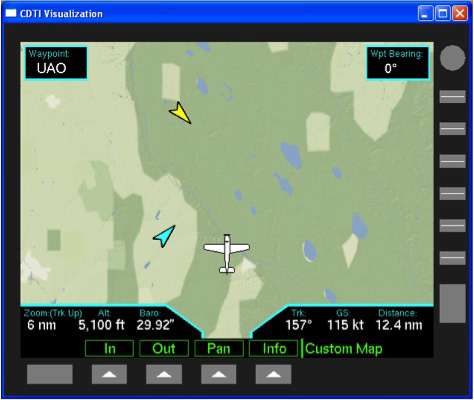Engineers find way to lower risk of midair collisions for small aircraft

Researchers at North Carolina State University have developed new modifications for technology that helps pilots of small aircraft avoid midair collisions. The modified tools significantly improved pilot response times in making decisions to avert crashes.
At issue are "cockpit displays of traffic information" (CDTIs). These are GPS displays used by private pilots to track other aircraft in their vicinity. However, pilots often focus on the closest aircraft on the display – a habit that can pose a significant hazard.
If the pilot of Plane A sees two planes on the CDTI, he's more likely to focus on the closest aircraft (Plane B). But if the more distant plane (Plane C) is moving at high speed, it could cross his path before Plane B does. Not paying enough attention to Plane C increases risk of a midair collision.
"Our goal was to modify a CDTI to help pilots recognize which other planes pose the greatest risk," says Carl Pankok, lead author of a study on the work and a Ph.D. student in the Edward P. Fitts Department of Industrial and Systems Engineering at NC State. "And it worked."
Researchers modified the CDTI so that the plane that would cross a pilot's path first either began blinking or was colored yellow.
The researchers tested the modified CDTI in a flight simulator with a panel of licensed recreational pilots. The research team compared the pilots' response times and decision-making accuracy when using the modified and unmodified displays.
"These pilots were already pretty good, but the modified CDTIs made them better," Pankok says. "Their percentage of 'correct' decisions – minimizing risk – jumped from 88 percent to 96 percent. And their response times in scenarios where the farther aircraft was the higher-risk aircraft were cut in half; from 7.2 seconds to 3.7 seconds for blinking CDTIs, and to 4 seconds for yellow CDTIs.
"We're not trying to make money off this," Pankok says. "We're hoping that CDTI manufacturers can incorporate these changes and possibly save lives."
More information: The paper, "Cockpit Displays of Traffic Information and Pilot Bias in Time-to-Contact Judgments," is published in the June issue of Aviation, Space, and Environmental Medicine. ingentaconnect.com/content/asm … 85/00000006/art00002
Provided by North Carolina State University


















